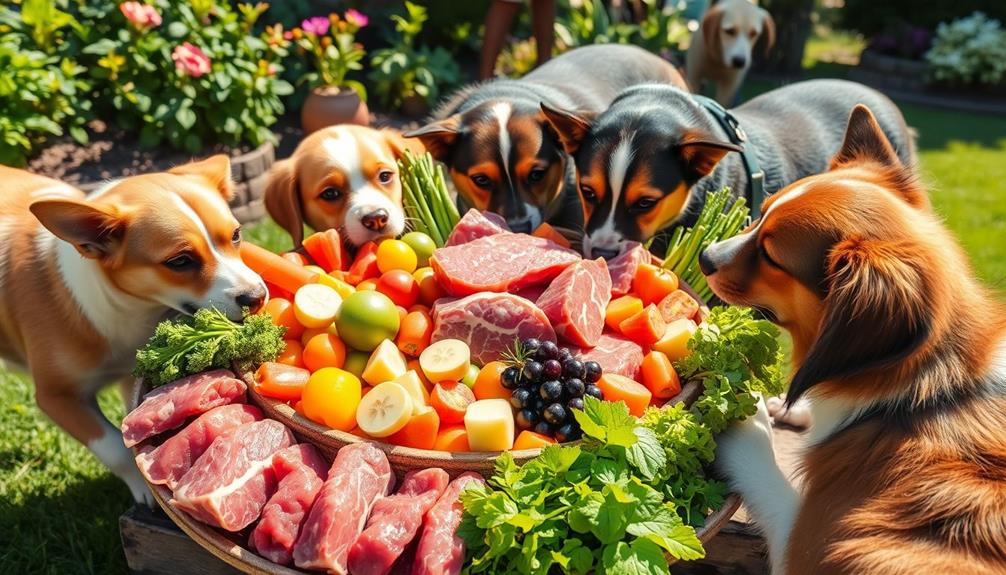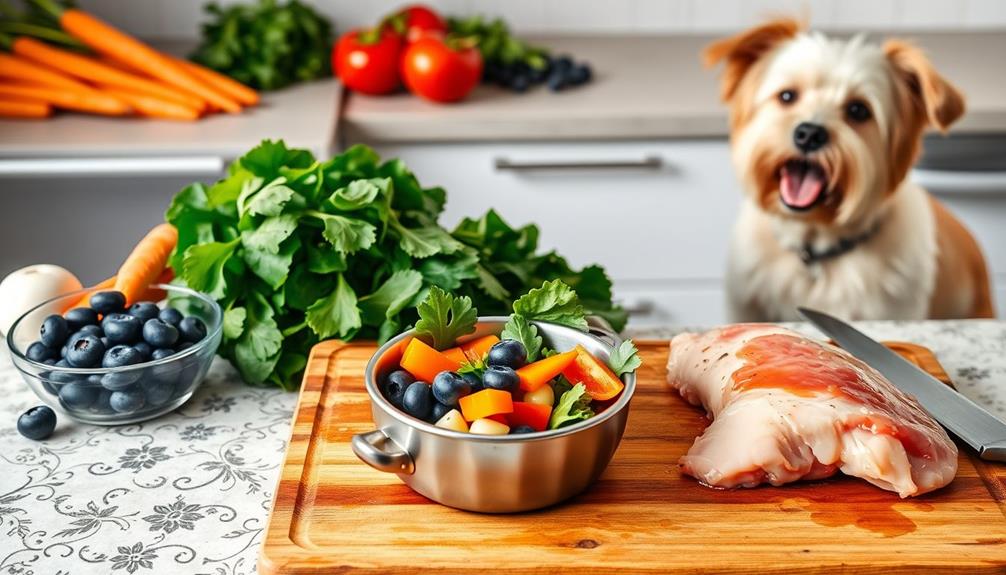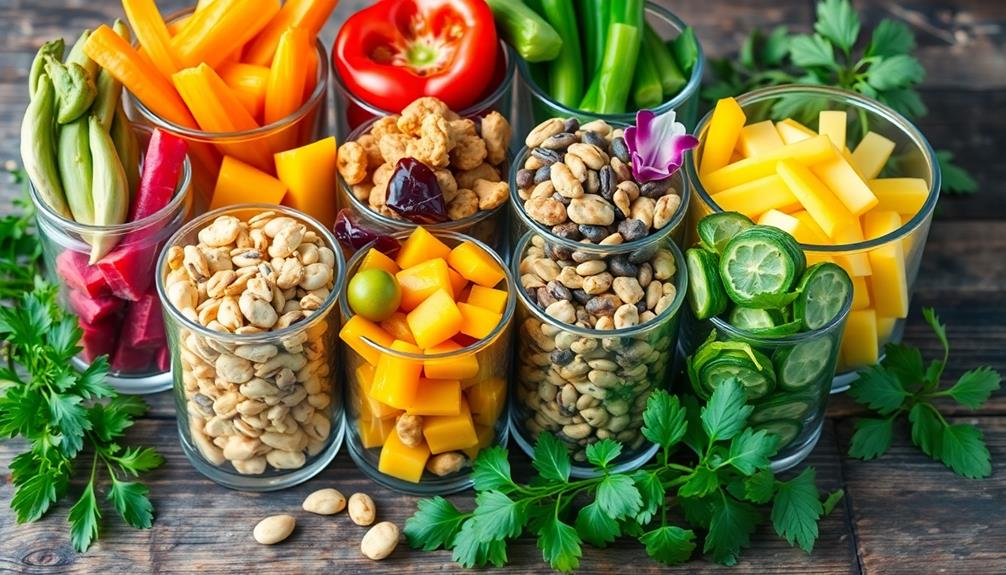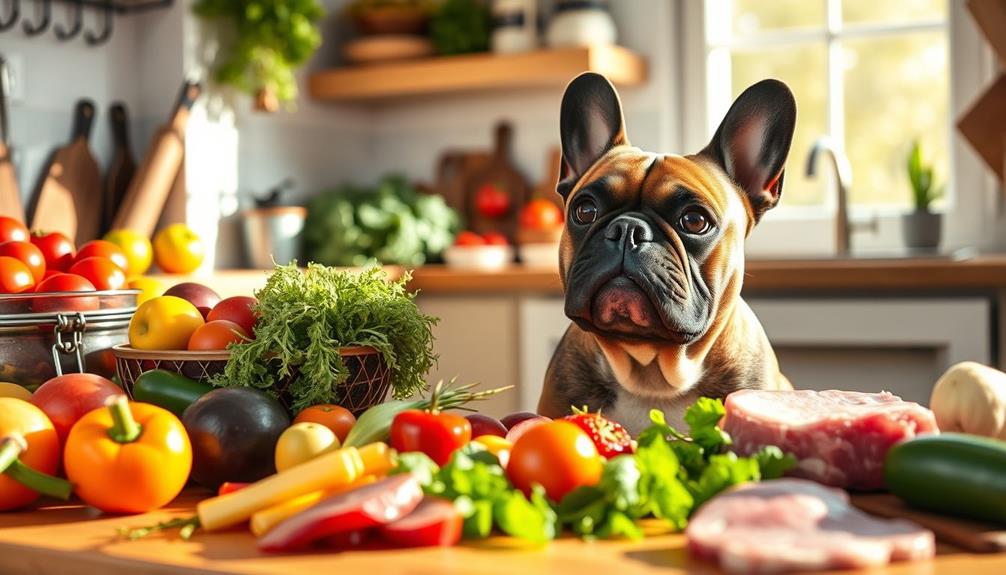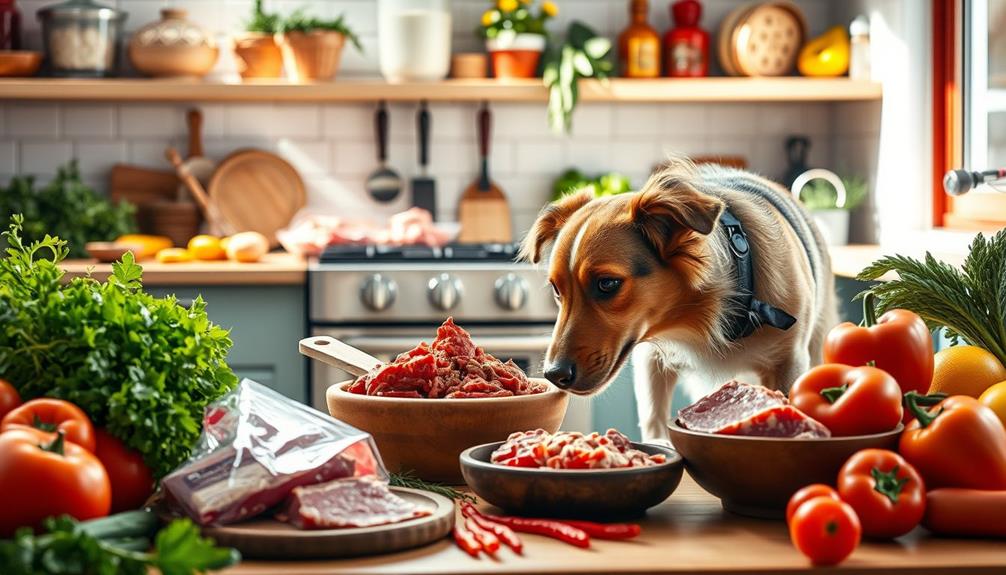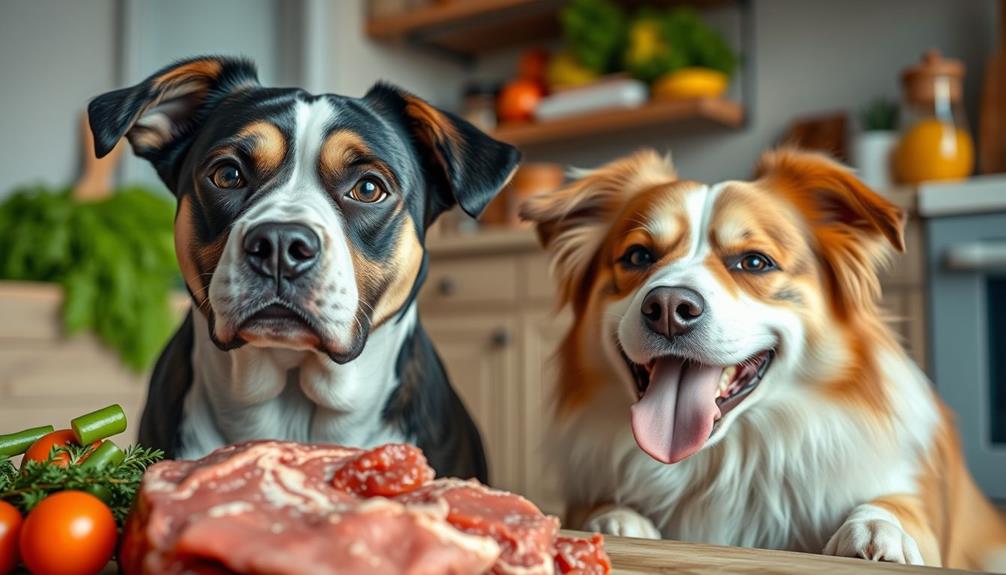A balanced raw food diet for dogs includes uncooked meat, organs, and bones, designed to meet their specific nutritional needs. Aim for 70% muscle meat, 10% raw bone, and 20% organ meats and vegetables. This balance promotes better digestion, healthier skin, and increased energy levels. It's vital to use high-quality ingredients and adhere to proper hygiene practices to minimize health risks. Also, consulting a veterinarian before making changes guarantees your dog gets essential nutrients without deficiencies. Understanding these fundamentals can enhance your dog's diet. You might find even more tips on how to implement this diet effectively. When implementing a raw food diet for dogs, it’s important to gradually transition them to the new diet to avoid digestive upset. Additionally, incorporating a variety of proteins such as beef, chicken, and fish can help ensure your dog receives a wide range of nutrients. Finally, monitoring your dog’s weight and overall health while on the raw food diet will allow you to make any necessary adjustments to meet their specific needs.
Key Takeaways
- A balanced raw food diet for dogs includes 70% muscle meat, 10% raw bones, and 20% organs and vegetables to ensure nutritional adequacy.
- Essential nutrients are provided through liver and other organs, contributing vitamins and minerals vital for a dog's health.
- Safety precautions, such as sourcing high-quality ingredients and practicing hygiene, are crucial to minimize health risks associated with raw feeding.
- Gradual transitioning to a raw diet is recommended, starting with a mix of 25% raw food and increasing over 10 days to avoid digestive issues.
- Consultation with a veterinarian is important to ensure the diet meets specific nutritional needs and to address potential health risks.
Understanding Raw Dog Food
When considering a balanced raw dog food diet, it's essential to understand what this approach entails. A balanced raw diet primarily consists of uncooked meats, organs, connective tissues, and bones, mirroring a dog's natural dietary needs.
To achieve this balance, you'll want to aim for about 70% muscle meat, 10% raw bone, 5% liver, and 5% other organs. This composition guarantees your dog receives the essential nutrients required for peak health. Regularly incorporating a variety of protein sources can enhance nutrient diversity and overall well-being, as highlighted in the proper diet for pets.
Incorporating various protein sources like beef, chicken, and lamb is vital to prevent nutritional deficiencies. Additionally, the calcium to phosphorus ratio should be approximately 1.4:1, emphasizing the importance of including raw bones in your dog's meals for bone health.
If you're considering a homemade raw diet, it's important to formulate it carefully to meet all necessary vitamins and minerals. Many pet owners risk imbalances by not adhering to established nutritional guidelines, which can lead to health issues.
Understanding these components of raw dog food will help you create a nourishing diet that promotes your dog's well-being and longevity.
Benefits of a Raw Food Diet
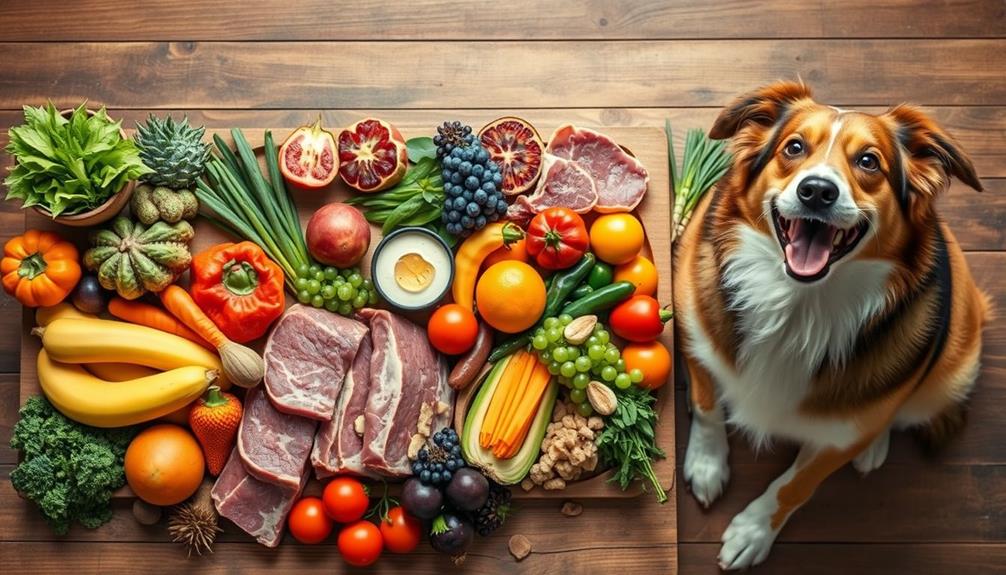
A balanced raw food diet offers numerous benefits that can greatly improve your dog's health and well-being. One of the key advantages is improved digestion. By feeding your dog natural ingredients, you'll likely notice smaller, firmer stools, which indicate better nutrient absorption.
Additionally, incorporating fresh ingredients can provide antioxidants and vitamins that contribute to overall health.
Furthermore, you'll probably see your furry friend sporting healthier skin and a shinier coat. This is often attributed to the moisture and healthy fats found in raw meats, giving your dog that radiant glow.
Here are a few other benefits you can expect from a raw food diet:
- Enhanced energy levels: Many owners report that their dogs become more active and playful after switching to raw food.
- Weight control: Raw feeding typically reduces indigestible carbohydrates, helping your dog maintain a healthy body weight.
- Better dental health: Chewing raw proteins and bones can lead to cleaner teeth and healthier gums.
Nutritional Balance Essentials
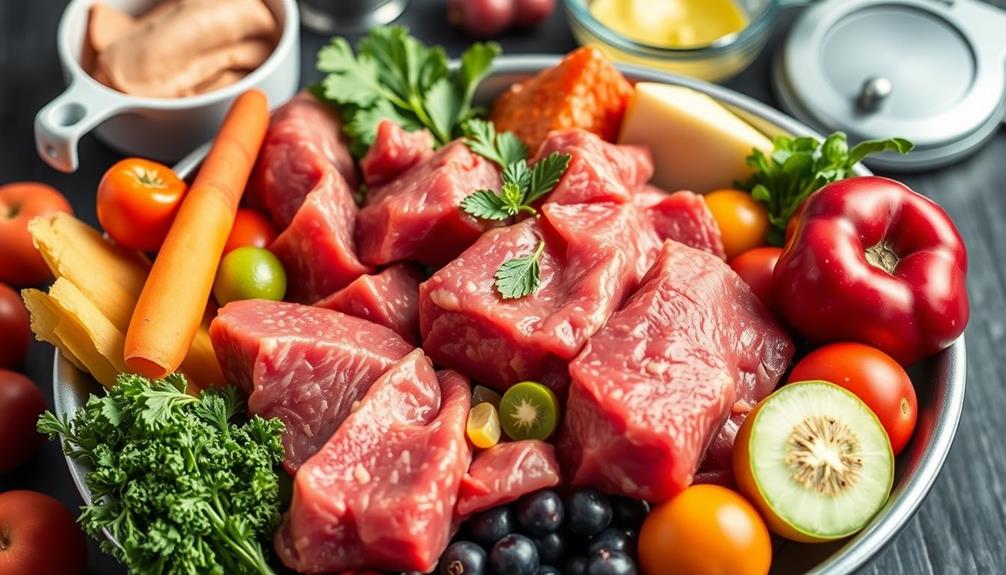
To guarantee your dog thrives on a balanced raw food diet, it's essential to understand the nutritional components that provide ideal health.
It's also important to reflect on how the dietary needs of pets can change as they age, similar to the evolving needs of seniors requiring financial planning for care.
Aim for approximately 70% muscle meat in their meals, as it's a primary protein source. Include about 10% raw bones for the essential calcium to phosphorus ratio of 1.4:1, ensuring your pup gets adequate calcium levels to support bone health.
You should also incorporate 5% liver and 5% other organs to deliver crucial nutrients that might be lacking in raw diets, such as vitamin E, zinc, and iodine.
Adding 7% vegetables and 2% seeds or nuts enhances the nutrient diversity, which is key for a balanced diet.
To prevent allergies and promote overall health, rotate between at least three different types of meat.
Adjust the total amount of raw food based on your dog's age, weight, and activity level, typically feeding them 2-3% of their body weight daily.
Safety Considerations

Understanding how to balance a raw food diet for your dog is only part of the equation; safety considerations play a significant role in ensuring your pet's health.
Raw pet food can harbor harmful bacteria like Salmonella and E. coli, with studies showing significant contamination rates. To keep your dog safe, it's vital to implement proper food safety practices.
Additionally, it's important to reflect on the nutritional aspects of the diet, as a well-rounded approach can prevent potential health issues related to cold medications overview and imbalances.
Here are some important safety precautions to keep in mind:
- Hygiene First: Always clean surfaces, utensils, and your hands before and after handling raw food to prevent cross-contamination.
- Freeze for Safety: Freezing raw meat at -4°F for at least seven days can help reduce the risk of parasites, though it doesn't eliminate it entirely.
- Stay Informed: Stay updated on the potential health risks associated with raw feeding, as improper practices can lead to nutritional imbalances and health issues for your pet.
Veterinary Perspectives
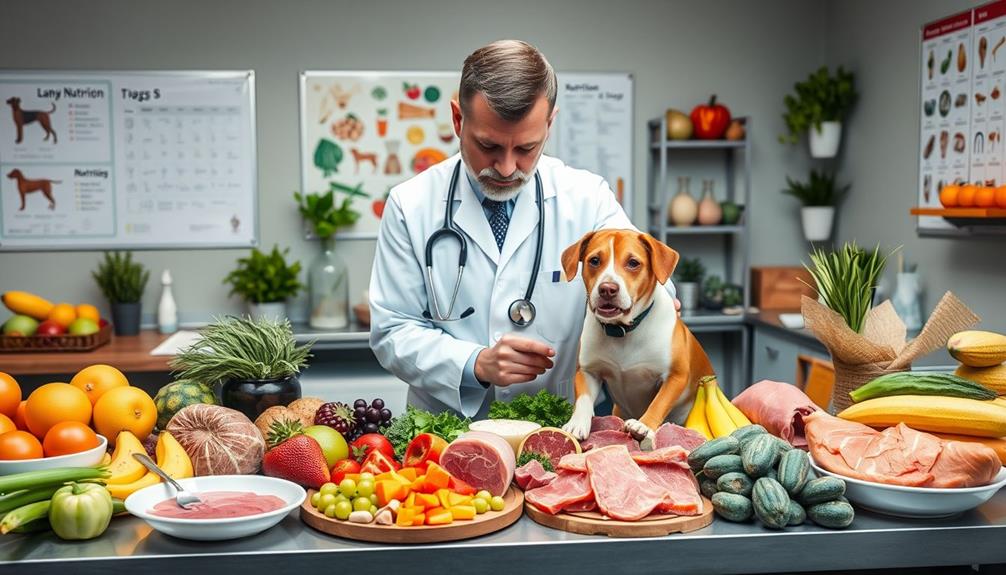
When considering a raw food diet for your dog, it's vital to be aware of the health risks and potential nutritional imbalances that can arise.
Many veterinarians stress the importance of consulting a professional to guarantee your dog's diet is properly balanced and safe.
This is especially important for certain breeds that may have specific dietary needs, similar to how mammography aims to detect breast cancer early for better treatment outcomes.
Ignoring these recommendations could lead to serious health issues for your furry friend.
Health Risks Awareness
Many veterinarians express concern over the health risks associated with feeding dogs a raw food diet. Major veterinary associations, like the American Veterinary Medical Association, caution that there's insufficient scientific evidence supporting the benefits of raw diets for dogs.
They highlight several potential health risks that can arise, including nutritional imbalances that might lead to conditions like nutritional osteodystrophy. Additionally, conducting proper checks on the quality of raw ingredients is essential, as ensuring workplace safety and compliance in food handling is vital for preventing contamination background checks in food handling.
Here are some key points to take into account:
- Pathogen Risks: Studies show that about 20% of commercial raw diets tested positive for Salmonella and 64% for E. coli, which can pose serious health threats to both pets and humans.
- Hygiene Practices: The FDA has issued warnings regarding the importance of hygiene when handling raw meat to prevent zoonotic disease transmission.
- Educated Decisions: Veterinary professionals emphasize the need for pet owners to be aware of the potential health risks and nutritional imbalances associated with raw feeding.
It's important to approach a raw food diet with caution, ensuring you fully understand the implications for your dog's health and well-being.
Nutritional Imbalance Concerns
While being aware of the health risks associated with a raw food diet, it's equally important to contemplate the nutritional imbalances that can arise. Veterinary associations, including the American Veterinary Medical Association, warn that many homemade raw diets often lack essential vitamins and minerals like vitamin E, zinc, and iodine. This can lead to deficiencies that negatively impact your dog's health.
Additionally, following a structured approach to budgeting for pet nutrition can help guarantee that you're providing a well-rounded diet for your furry friend, allowing you to allocate resources effectively for high-quality ingredients and supplements. Creating a personal budget for your pet's diet can help avoid these pitfalls.
A study indicates that pet owners frequently create raw diets without scientific guidance, resulting in significant nutritional gaps. One vital concern is maintaining the proper balance of calcium and phosphorus, which should ideally be at a 1.4:1 ratio to support best bone health. Failure to achieve this balance can lead to nutritional osteodystrophy, a serious health issue.
Moreover, research shows that many pet owners don't use structured recipes, leading to variations in nutrient intake. This inconsistency can heighten the risk of nutritional imbalances, affecting your dog's overall well-being. As a result, understanding these concerns is important before committing to a raw food diet, as it can have lasting consequences on your furry friend's health.
Importance of Consultation
Consulting a veterinarian is crucial before making any significant dietary changes for your dog, especially when considering a raw food diet.
Major veterinary associations, like the American Veterinary Medical Association, advise against raw feeding due to potential health risks. It's important to understand the significance of consultation to guarantee your dog receives a balanced and complete diet.
Additionally, just as with human development, dogs also experience growth stages that require specific nutritional needs to support their overall health and well-being, including digestive health key domains of development in psychology.
Here are a few key reasons why you should consult a vet:
- Nutritional Knowledge: Many homemade raw diets lack the scientific formulation needed for balanced nutrition, leading to deficiencies in essential vitamins and minerals.
- Health Risks: Raw feeding can result in specific health issues, such as nutritional osteodystrophy, which underscores the necessity for professional guidance.
- Safe Practices: Discussing feeding raw diets with a veterinarian helps you learn about safe feeding practices, avoiding potential health imbalances.
Preparation Methods
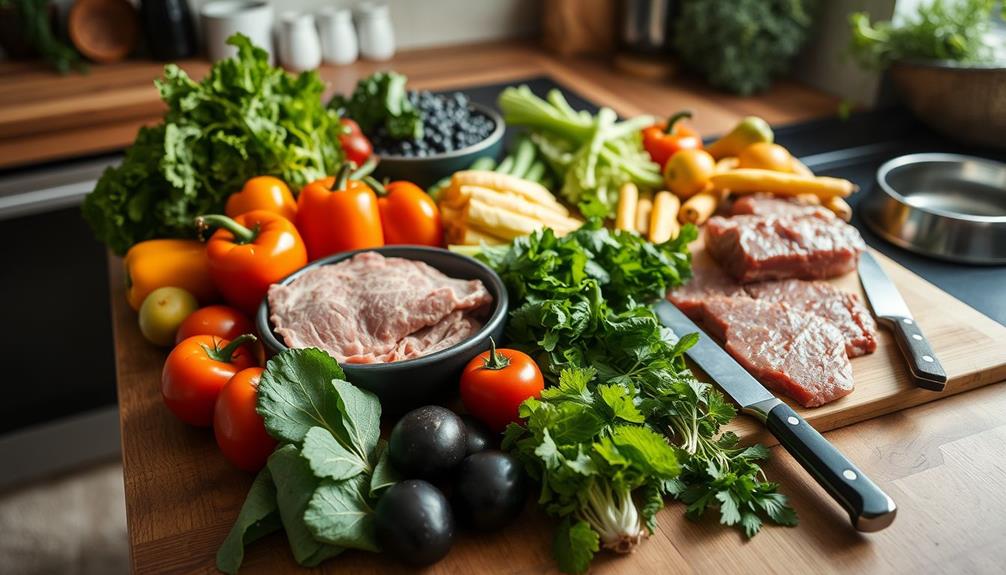
When preparing a balanced raw food diet for your dog, selecting high-quality ingredients is essential.
You'll need to focus on fresh meats, organ meats, and a variety of vegetables and fruits to guarantee proper nutrition.
To minimize risks and maintain hygiene, it's also important to implement proper piercing care and hygiene practices in your kitchen.
Understanding effective preparation techniques will help you maintain hygiene and maximize the diet's benefits.
Raw Ingredients Selection
Choosing the right raw ingredients for your dog's diet is important for their overall health and well-being. A balanced raw food approach should include a variety of ingredients to guarantee your pup gets all the necessary nutrients. Aim for approximately 70% lean muscle meat, 10% raw bones, and 5% liver, complemented by other organs, vegetables, seeds, nuts, and fruit.
Additionally, incorporating a range of fruits and vegetables can provide important vitamins and antioxidants that support your dog's immune system and overall wellness, which is critical for longevity in pets balanced diet rich in fruits.
Here are some tips to help you select the best ingredients:
- Diversify protein sources: Incorporate different types of meat, such as chicken, beef, or fish, to enhance nutrient diversity and reduce allergy risks.
- Prioritize organ meats: Including liver and other offal is essential, as they're packed with important vitamins that support your dog's health.
- Maintain calcium and phosphorus balance: Use raw bones as a primary calcium source, confirming the calcium to phosphorus ratio remains around 1.4:1 for ideal bone health.
Preparation Techniques Overview
Preparing a balanced raw food diet for your dog requires careful attention to detail to guarantee the right nutritional balance. Start by sourcing high-quality, human-grade ingredients, such as muscle meat, bones, and organ meats.
When crafting homemade raw diets, it's vital to stick to proper ingredient ratios, aiming for about 80% meat (including offal) and 10% bone. This guarantees your dog receives the necessary nutrients for peak health. Additionally, incorporating healthy dog snacks into their diet can further enhance their wellness and satisfaction.
Handling raw meat is vital to prevent contamination. Always wash your hands thoroughly and clean surfaces and utensils before and after preparation.
Consider incorporating dietary supplements, like fish oils for omega fatty acids and vitamin E for inflammation reduction, to boost the nutritional value of your dog's meals.
If you find the preparation process overwhelming, you might opt for pre-made raw food options. These can simplify your feeding routine while still providing a balanced diet formulated by experts.
Regardless of the method you choose, maintaining strict hygiene and proper ingredient ratios will help guarantee your dog thrives on a balanced raw food diet.
Transitioning to Raw Diet
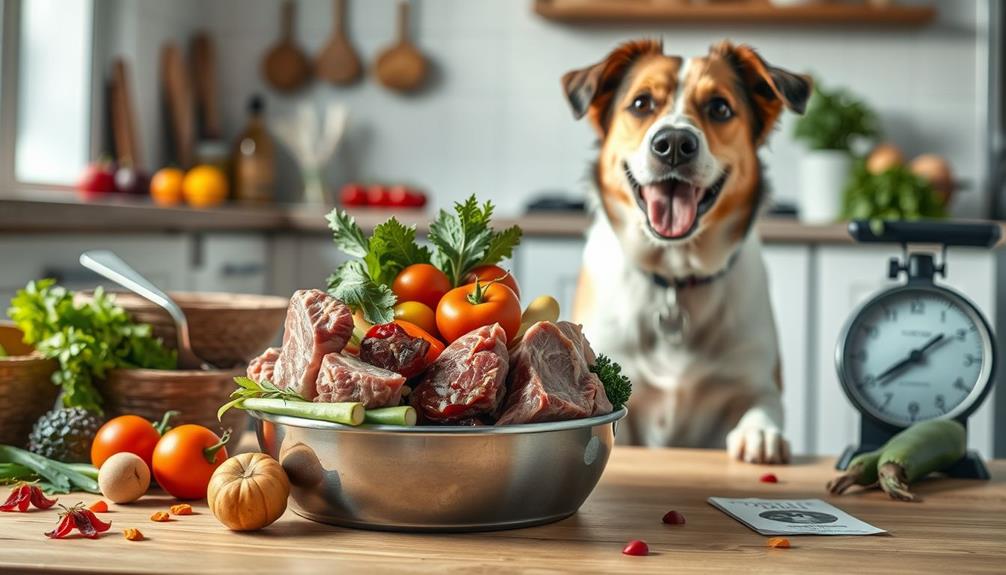
Shifting your dog to a raw diet can be a smooth process if done gradually. Start by mixing 25% raw food with 75% of their current diet for the first three days.
After this initial phase, increase to a 50/50 mix for another three days. By Day 10, your dog should be fully converted to a raw diet, ensuring their digestive system adapts well.
Keep in mind the following tips during the conversion:
- Monitor your dog's reactions closely to identify any gastrointestinal upset.
- Adjust the daily raw food intake to 2-3% of your dog's body weight, depending on their activity level and health.
- Consider homemade raw diets for a personalized touch, ensuring balanced nutrition.
Common Misconceptions
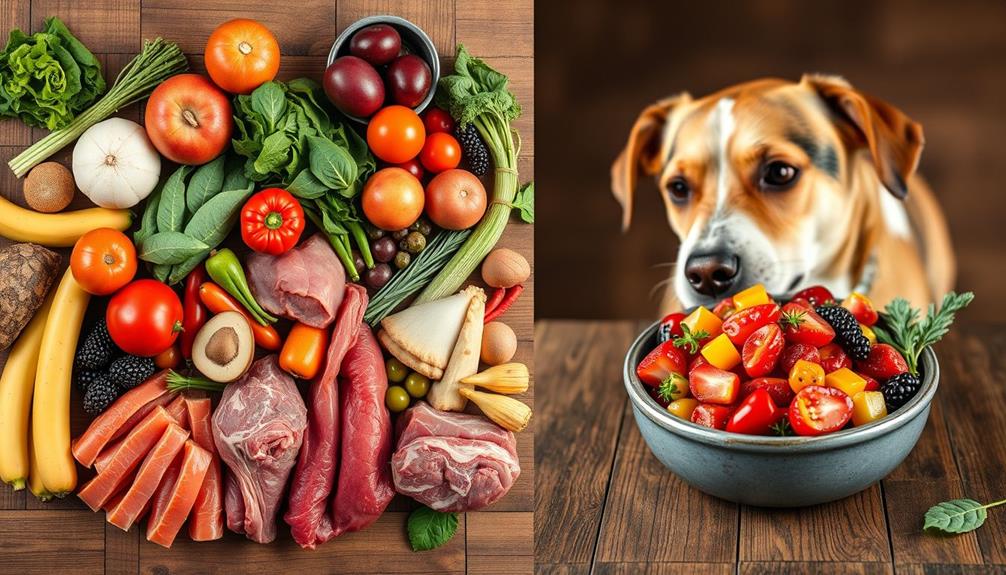
You might think that raw food equals natural nutrition for your dog, but that's not the whole picture.
Many believe all meat is sufficient for a balanced diet and that homemade meals are always safe, yet these assumptions can lead to serious nutritional gaps or health risks.
Let's clear up these misconceptions to guarantee your furry friend gets the best care possible.
Raw Equals Natural Nutrition
Many dog owners mistakenly believe that a raw food diet isn't natural for their pets, often associating raw feeding with unsafe practices or nutritional imbalances.
However, dogs have evolved to thrive on a diet that closely resembles their ancestral meals. A balanced homemade raw food diet can provide the essential nutrients your dog needs to stay healthy.
Here are some key points to reflect on:
- Dogs digest raw meat efficiently, making it a natural choice for their dietary needs.
- A balanced raw food diet includes a variety of ingredients, ensuring your dog gets all necessary vitamins and minerals.
- Raw feeding can lead to better overall health, from improved coat condition to increased energy levels.
When you incorporate 70% muscle meat, 10% raw bones, and other components, you're not just feeding your dog—you're promoting a healthy dog lifestyle.
Misconceptions about raw feeding often stem from a lack of understanding about canine nutritional needs. By educating yourself on how to create a balanced homemade raw diet, you can confidently provide your furry friend with natural nutrition that supports their health and well-being.
All Meat Is Sufficient
While a balanced raw food diet can provide dogs with the nutrients they need, some pet owners mistakenly think that feeding their dogs solely meat is enough. This common misconception can lead to serious nutritional imbalances. Dogs require a variety of food sources to thrive, so solely providing muscle meat can result in deficiencies in essential nutrients.
Here's a breakdown of what a balanced raw food diet should include:
| Component | Percentage | Essential Nutrients |
|---|---|---|
| Muscle Meat | 80% | Proteins, B vitamins |
| Raw Bones | 10% | Calcium, phosphorus |
| Organ Meats | 10% | Vitamins A, E, copper, zinc |
Homemade Is Always Safe
Believing that homemade raw diets are always safe can lead to serious nutritional pitfalls for your dog. Many pet owners mistakenly assume that these diets provide balanced nutrition, but they often lack the scientific formulation needed for ideal health. This oversight can result in vitamin and mineral deficiencies that affect your dog's well-being.
Consider these common misconceptions:
- Calcium to Phosphorus Ratio: Most homemade raw diets fail to achieve the perfect 1.4:1 ratio, essential for healthy bone development.
- Pathogen Risks: Homemade meals can harbor harmful pathogens like Salmonella and E. coli, posing risks to both your pet and your family.
- Nutritional Gaps: Common deficiencies in homemade raw diets include vitamin E, zinc, and iodine, often requiring supplementation for balance.
As a responsible pet owner, it's essential to educate yourself on proper raw diet preparation. A balanced nutrition plan is key to your dog's health and longevity.
Don't let the misconception that homemade raw diets are inherently safe put your furry friend at risk. Take the time to guarantee their meals are complete and safe for consumption.
Selecting Quality Ingredients
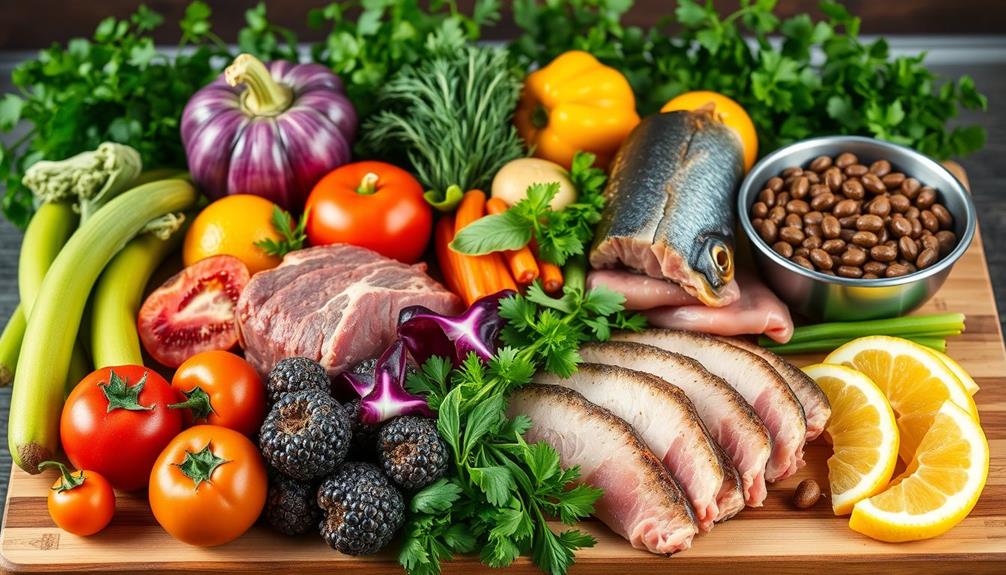
Selecting quality ingredients is vital for crafting a balanced raw food diet for your dog. Aim to include approximately 70% lean muscle meat, 10% raw bone, 10% organ meat (with 4-5% from liver), and 10% vegetables. This combination guarantees a thorough nutrient profile that supports your dog's overall health.
It's important to maintain a calcium to phosphorus ratio of around 1.4:1, primarily sourcing calcium from raw bones. This balance supports bone health and prevents deficiencies.
Incorporating a variety of protein sources enhances nutrient diversity and reduces the risk of food allergies, so rotate between at least three different meats.
Always source high-quality ingredients from USDA-certified suppliers. This assures safety and nutrient integrity, steering clear of low-quality fillers or additives often found in processed pet foods.
Regularly assess the quality of your ingredients and their nutritional balance, as many homemade raw diets can lack scientific formulation, risking essential nutrient deficiencies.
Recommended Feeding Guidelines
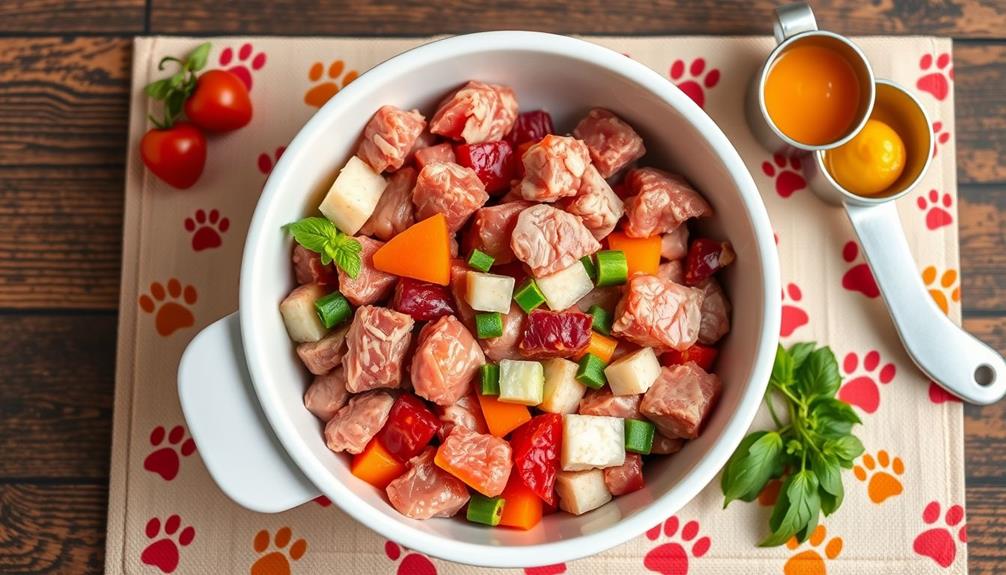
Establishing a balanced raw food diet is only part of the equation; understanding how much to feed your dog is equally important. The recommended feeding guidelines suggest giving 2-3% of your dog's body weight in raw food daily. For instance, a 100-pound dog needs about 2-3 pounds of food, while a 50-pound dog would require roughly 1-1.5 pounds.
When you're adapting to feeding dogs raw, it's essential to do it gradually. Follow this simple plan:
- Start with 25% raw food and 75% current food for three days.
- Progress to a 50/50 mix for another three days.
- Finally, shift to 75% raw for the last four days.
During this adjustment, monitor your dog's weight and health closely.
A balanced raw diet typically consists of 70% lean muscle meat, 10% raw bone, 5% liver, 5% other organs, 7% vegetables, 2% seeds/nuts, and 1% fruit.
Adjust the feeding amounts based on your dog's activity level and life stage to make sure they're getting the right nutrients.
Frequently Asked Questions
How to Properly Balance a Raw Diet for Dogs?
To properly balance a raw diet for your dog, mix 70% muscle meat, 10% raw bone, 5% liver, 5% organs, plus veggies, seeds, and fruits. Adjust based on your dog's needs and monitor their health regularly.
What Should a Dog's Raw Diet Consist Of?
Isn't it important for your dog to thrive? A raw diet should include 80% muscle meat, 10% raw bone, 5% liver, and 5% other organs, ensuring balanced nutrition for ideal health and energy.
How to Make a Well Balanced Raw Dog Food?
To make a well-balanced raw dog food, include 70% lean meat, 10% raw bone, and 5% liver. Rotate proteins, add veggies, and consult a vet to guarantee it meets your dog's specific nutritional needs.
What Is a Well-Balanced Diet for Dogs?
A well-balanced diet for dogs includes quality proteins, healthy fats, and appropriate carbohydrates. You should incorporate a mix of meats, vegetables, and supplements to guarantee your dog gets all the essential nutrients for peak health.
Conclusion
In conclusion, a balanced raw food diet can be a game-changer for your dog's health and well-being. By understanding the essentials of nutrition, ensuring safety, and making the shift thoughtfully, you can provide your furry friend with meals that are as exciting as a treasure hunt! Don't forget to consult your vet and choose high-quality ingredients to keep your pup thriving. With a little effort, you'll reveal a world of health benefits that'll have tails wagging like never before!

